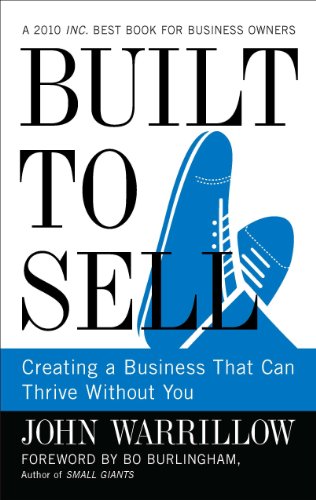
BUILT TO SELL: A SUMMARY
I bet you’ll find yourself (like me) recommending this book to your friends who want to sell their business one day, but don’t understand what that’s going to take.
- Seth Godin Tweet
Whether you plan to sell your business or not, building it in a way that makes it manageable and scalable should be everyone’s goal.
Story Summary
Introduction
“Built to Sell” tells the captivating story of Alex Stapleton, an entrepreneur who embarks on a journey to create a valuable and sellable business. Faced with the challenges of his advertising agency’s reliance on him, Alex seeks guidance from his mentor, Ted, who helps transform the company into a successful enterprise worth $5 million. This engaging narrative serves as a guide for entrepreneurs, teaching them the essential steps to build a business that can thrive independently, making it an appealing acquisition target.
Turn a Worthless Company Around
Alex owns the Stapleton Agency, an advertising agency with seven employees. The agency’s senior designer, Sarah, works on projects for MNY Bank, their key client. During a meeting with John Stevens, the head of marketing at the bank, Alex presents eight different mockups for the bank’s brand. However, after a discussion with Sarah, he learns she plans to quit, leaving him concerned. Additionally, the agency is facing financial difficulties, and the other employees lack expertise in their tasks.
Seeking advice, Alex meets with Ted, a successful entrepreneur who has sold multiple companies. Ted highlights the agency’s financial struggles and the intense competition it faces, suggesting that significant changes are needed before selling the company.
Follow a Five-Step Design Process
To improve the agency’s performance, Ted advises Alex to specialize in a specific area and hire experts rather than generalists. He shares a five-step design process they used to create the agency’s best work, including gathering client goals, sketching ideas, creating a refined design based on feedback, developing a sell sheet, and seeking feedback from previous clients. Ted emphasizes the importance of avoiding over-reliance on a single client for revenue, as MNY Bank accounts for 40% of the agency’s income.
Sell the Process
Ted advises Alex to develop a process that allows him to control every aspect of the company. This includes establishing positive cash flow cycles, such as requesting upfront payments from clients, and finding employees who can deliver the same quality of work. To achieve this, Alex creates an instruction manual explaining the logo design process and presents it to his team. Although one designer, Elijah, disagrees with the strategy and decides to leave the company, Alex sees it as an opportunity for improvement.
Build a Sales Team
Ted emphasizes the importance of a stable team when attracting potential buyers. To strengthen his sales engine, Alex decides to let go of his account director and copywriter, enabling him to hire two salespeople. He brings in Blake, an experienced advertising professional, and Angie, a successful product salesperson for small businesses. Recognizing the need for a product specialist, Alex hires Angie and reunites with Seamus, a former colleague.
Ted reassures Alex that although they might face financial challenges in the next two years, they will implement a new system to improve their profitability. Ted’s ultimate goal is to increase the company’s value to $5 million, considering its current worth is less than $500,000.
Implementation Guide
Accountant
Hiring a good accountant with expertise in tax strategies is a crucial step in preparing to sell your business. It is advisable to engage their services well in advance of the actual sale to ensure a smooth and efficient process.
Scalability
When considering the products or services within your business, focus on identifying those with the potential to scale. Scalability is determined by three key factors.
- Firstly, the product or service should be teachable to employees or deliverable through technology.
- Secondly, it must deliver significant value to customers. However, it is important to note that the most teachable offerings may not always be the most valuable, so finding a balance is crucial.
- Lastly, prioritize offerings that generate recurring revenue, as this is the cornerstone of scalability.
Repeatability
Within the realm of scalability, repeatability is the most crucial aspect. There are six types of repeatable businesses to consider.
- Consumables, such as toothpaste, require customers to repurchase frequently.
- Sunk money consumables, like razor blades or ink cartridges, involve an initial investment followed by recurring purchases.
- Renewable subscriptions, such as eMagazines, require ongoing subscriptions for revenue generation.
- Sunk money renewable subscriptions, like Bloomberg terminals, involve upfront costs as well as subscription fees.
- Auto-renewal subscriptions, such as document storage services, automatically renew, ensuring recurring revenue.
- Lastly, contracts, such as multi-year mobile phone plans, provide a stable source of revenue.
To establish a scalable and repeatable business, it is essential to create a detailed instruction manual for your business process. Naming and documenting this process will ensure consistency and efficiency in its execution.
No RFPs
Avoid relying on responding to Requests for Proposals (RFPs) as a primary method for winning business.
Cash Flow
Instead, aim to create a positive cash flow cycle by requesting upfront payments from customers. This approach contributes to the financial stability of your business.
Customer Advisory Boards
The author of the outline suggests progressing from running focus groups to establishing customer advisory boards. Additionally, they recommend transitioning towards releasing industry research reports, emphasizing the importance of a one-size-fits-all approach rather than customization.
Operating Capital
When approached with offers to buy your business, pay close attention to the amount of operating capital that will be left in the account. It is important to remove yourself from the sales process by hiring two sales representatives, allowing you to focus on selling the company while they handle product sales.
Remove Yourself from Sales
The sales process should be designed to be simple rather than built around a comprehensive understanding of multiple scenarios that may take years to develop. By simplifying the sales process, it becomes more efficient and effective.
No Customization
Stick to your primary offering and refrain from selling a wide range of products or services. Avoid customization and instead focus on delivering a consistent and standardized offering.
Align Compensation Plans
It is crucial to align the compensation plans of your employees, particularly the general manager, with long-term customer loyalty. This ensures that they prioritize acquiring long-term contracts over short-term profit margins.
Create a Moat
Selling people’s time can make your business overly dependent on employees. To mitigate this risk, create a wide and deep “moat” around your business. This moat refers to measures that provide pricing protection and make it challenging for employees to leave and compete against you. Examples include owning ranking studies, awards programs, industry events, and benchmark measurements.
Convert an LOI to a Deal
During the selling process, aim to convert offers into contractual deals rather than relying solely on a Letter of Intent. Earnout money should not be counted on, so it is essential to secure upfront payments to ensure you receive the desired funds.
Beware Dirty Tricks
Be aware of potential dirty tricks employed by buyers, such as changing meeting times to assess your flexibility and the business’s dependence on you. They may also interview management and you separately to compare answers and talk to clients to gauge their loyalty to you as the owner. The due diligence period typically lasts 60-90 days, and the final offer may be lower than stated in the Letter.
Don’t be afraid to say no to projects. Prove that you’re serious about specialization by turning down work that falls outside your area of expertise.
- John Warrillow Tweet
Ted’s Tips
Niche Down
To succeed in business, it is important to specialize rather than generalize your offerings. By focusing on a specific niche, you can establish yourself as an expert in that area. Additionally, it is crucial not to rely too heavily on a single client, as this can make your business vulnerable. It is recommended to limit the dependency on one client to a maximum of 15% of your total client base.
Process
Owning a well-defined process for delivering your service or product gives you greater control and makes it easier to pitch to potential clients. Clearly outlining what you are selling and how you deliver it enhances clarity and sets you apart from competitors. It is important to avoid becoming synonymous with your company, as this can limit your options for growth and exit strategies.
Standardize
Standardizing your service and giving it a specific name, along with detailing the steps involved and the associated features and benefits, adds value and clarity to your offering. Charging upfront for your products or services can significantly improve your cash flow and financial stability.
Say No
Learn to say no to projects that do not align with your criteria or target market. It is essential to understand the number of prospects in your pipeline that are likely to convert into sales. This evaluation will help you gauge your potential market size and make informed business decisions.
Hire More Sales
Instead of relying on a single sales representative, consider hiring two to increase your sales capacity and reach. When making the transition from selling services to products, it is advisable to hire individuals who have expertise in selling products rather than services. Pay less attention to your profit and loss statement in the year of the transition.
2 Years of Experience
Before attempting to sell your company, it is recommended to have at least two years of experience selling a product. Building a strong management team with a long-term compensation plan that rewards loyalty is crucial for the success and stability of your business.
Choose an Advisor
When seeking an advisor, choose someone who does not consider you their largest or smallest client. Avoid advisors who try to broker deals with a single client, as this may not be in your best interest. Writing a comprehensive three-year business plan that explores the full potential of your business, including expansion plans, can help guide your strategic decisions.
3 Year Plan
Use the language and mindset of a product-selling business rather than a service-based one. During the sale process, avoid offering equity or stock options to current management staff. Instead, provide bonus incentives based on the successful sale of the company. These rewards should be paid in one or two installments, but only to those who remain with the company.
Conclusion
You will need to read the book to understand the actionable details. The author provides many more real-world application examples. You can learn more about Built to Sell on the author’s website here.
This book is a classic and highly recommended.

Built to Sell: Creating a Business That Can Thrive Without You by John Warrillow (28-Feb-2013) Paperback
By John Warrillow (Author)
Author Bio
Benjamin Arritt

Share:
Follow Us:
Most Popular


10+ PERSONAL CRM OPTIONS REVIEWED

10 OUTSOURCED BDR SALES AGENCIES COMPARED

FRACTIONAL MARKETING: EFFICIENT BUSINESS GROWTH
Subscribe To Our Newsletter
No spam. Curated directories & articles about business, startups and templates.
MENU
Related Posts

How to Build a High-Performing Marketing Stack for CMO Success
Dive into our blog post to learn how chief marketing officers can transform from brand champions to revenue drivers and customer whisperers through a strategic

10+ PERSONAL CRM OPTIONS REVIEWED
Yes, there are “solutions,” but nothing is perfect. Here is the path of what I evaluated, what I liked, what I didn’t and why. I

10 OUTSOURCED BDR SALES AGENCIES COMPARED
I interviewed several of the top performers according to Clutch, but this was not my exclusive source. Here’s why: some smaller companies, without as much

FRACTIONAL MARKETING: EFFICIENT BUSINESS GROWTH
Fractional marketing involves hiring fractional marketers, or part-time marketing professionals. This way businesses can leverage specialized expertise while reducing the costs associated with a full-time
